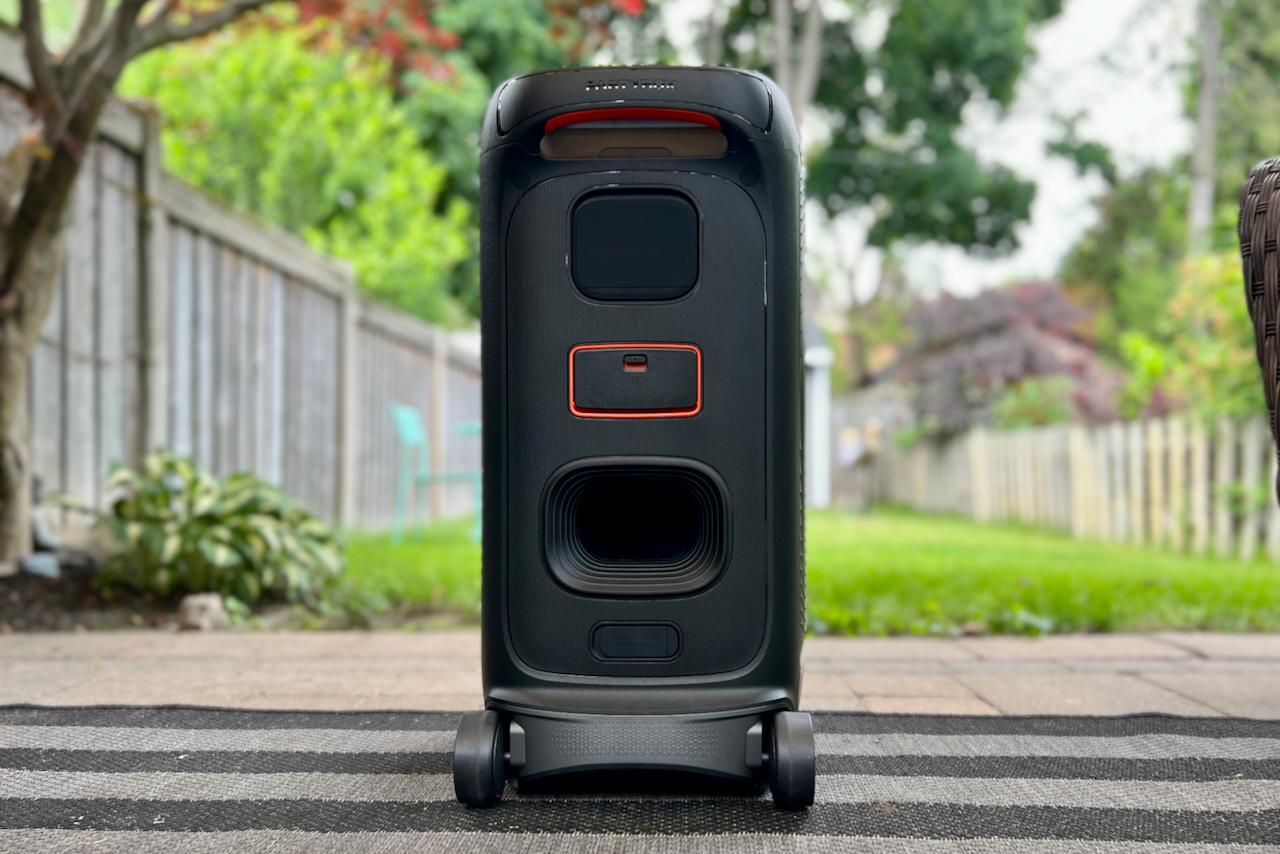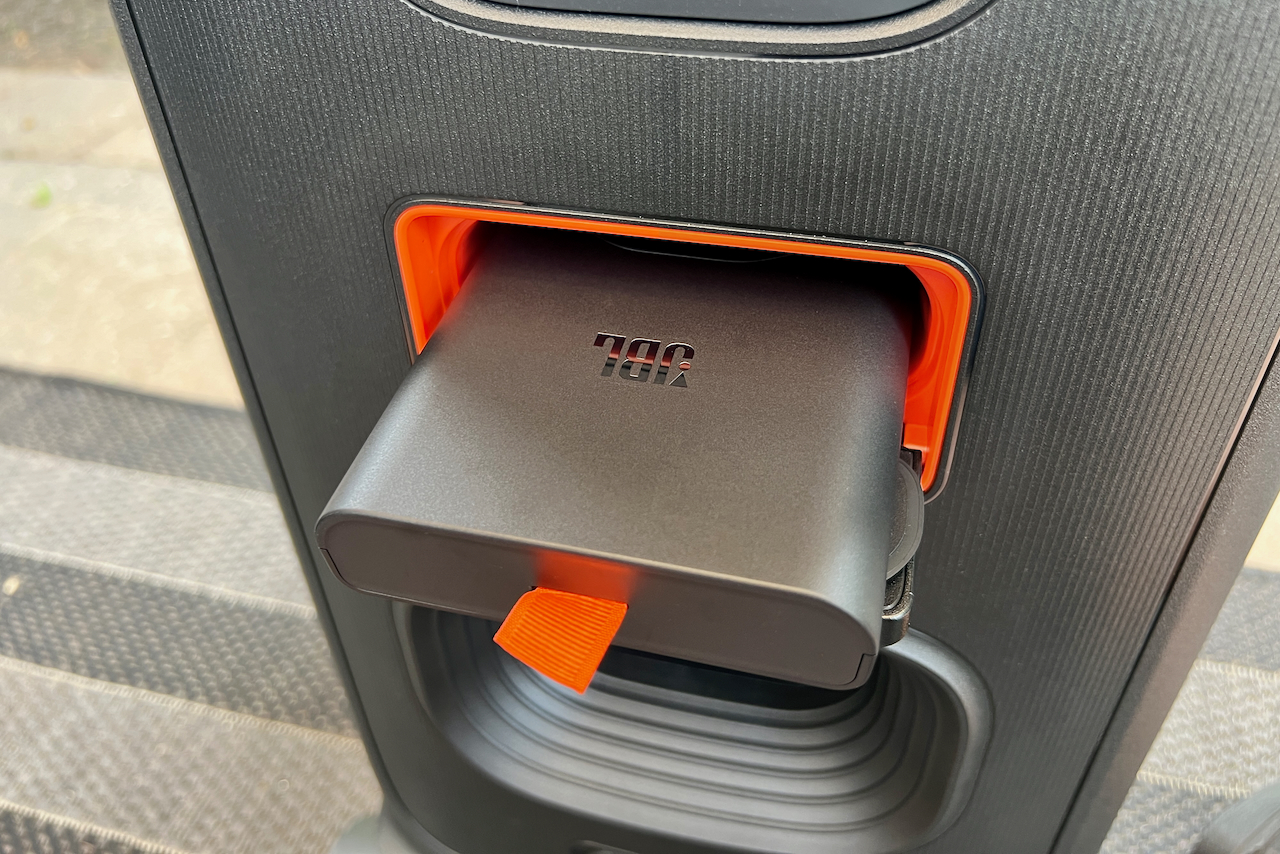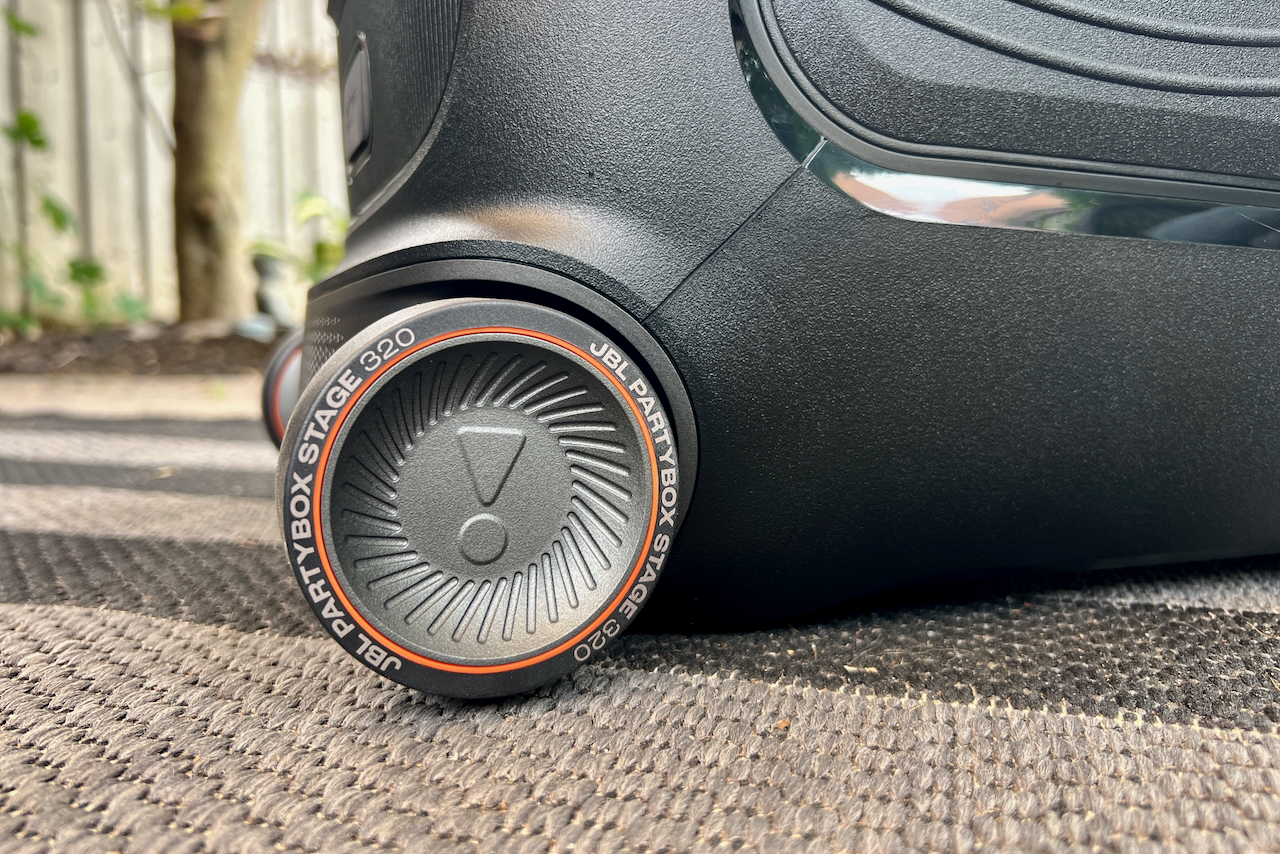“Roll it in. Turn it on. Turn it up. The JBL PartyBox Stage 320's huge, clear sound and light show will do the rest.”
- Loud, room-filling sound
- Superb clarity at high volumes
- Sturdy, solid build
- Auracast multispeaker connectivity
- Removable 18-hour battery
- A bit pricey
- No Wi-Fi connectivity
- DJ sound effects are cheesy
When I reviewed JBL’s monster flagship party speaker — the 1,100-watt PartyBox Ultimate –last year, I had my hair thoroughly blown back by its sheer power and pristine clarity. But as impressive as it is for pro DJs and other big-room party-throwers, I wondered about JBL’s smaller PartyBox speakers, which are more manageable in size and price. Luckily, the new year has brought a new crop. And JBL’s new PartyBox Stage 320 scratches that itch perfectly.
A whomping 240-watt rollable party, the Stage 320 is half the weight, roughly a third of the price, and offers many of the same features as the Ultimate, such as an LED lightshow, karaoke and DJ fun, and multispeaker linking. The Stage 320 also has a few step-up surprises that have come with JBL’s upgraded 2024 lineup that includes the portable JBL Xtreme 4 and smaller party speaker, the PartyBox Club 120. These features include the company’s AI-driven Sound Boost tuning, improved Auracast Bluetooth connectivity for linking an unlimited number of compatible speakers, and an 18-hour battery that’s (!) replaceable.
The Stage 320 is still big, make no mistake. And it’s still $600. But if you’re a budding DJ or just someone who likes to roll up to a party with the power and fun features required to get people out of their seats, then the JBL Stage 320 is going to do it for you, if the price doesn’t scare you off. After about a week with the PartyBox Stage 320, here’s what I liked and didn’t.
Design

On a recent trip to New York City, I was fascinated by the number of party speakers I spotted in the wild, buried in I Heart NY merch in Times Square storefronts, mounted on the sides of food carts covered in grease and hot sauce, and especially hanging off the backs of lit-up, pink-feathered pedicabs blasting Empire State of Mind. I get why. It’s hard to compete with the sounds and blinding lights of the city that never sleeps. But these seemingly bulletproof party speakers have the power and the eye-catching dazzle to cut through the insanity and take a beating while doing it.
OK, so maybe you’re not planning on setting up a souvlaki cart in Times Square anytime soon. But if you’re looking for a party speaker designed to take it, the Stage 320 (which is the successor to 2020’s PartyBox 310) would be an excellent choice. Like all JBL’s PartyBox speakers, the Stage 320 is a big, rollable speaker on hardy wheels that weighs just over 36 pounds and measures 13.3 by 26.3 by 15.2 inches (D x H x W), to be exact, or about the same as a medium-sized suitcase. And, luckily, it has a helpful suitcase-style telescopic handle that extends so you can pull it around like one, or you can grip it by the wide back handle to lift it up (but be sure to lift with the legs, please).

Its body is made of a thick, solid plastic shell that houses two 6.5-inch woofers and two 1-inch tweeters that are well protected behind a metal mesh grille. The woofers’ rims are ringed by LED lights that make a cool-looking infinity symbol when lit up. The face of the speaker is also dotted by six strobe lights on the left and right front edges, and the top and bottom edges each have an LED strip.
The back panel has a bit more going on than usual with JBL’s party speakers, due to the addition of a panel that houses the removable battery. Above that is another panel that conceals all the inputs and controls for the speaker (which we’ll get into below), and on the bottom-rear of the speaker is a passive bass port and a small cover for the AC power cable port.
Everything, of course, is well sealed and rugged to comply with the Stage 320’s IPX4 water-resistance rating, which means that I won’t be throwing it in the lake like I did with its much smaller cousin, the JBL Xtreme 4. But it does mean that the Stage 320 will withstand splashes, rain, and various beverages spilled on it.
Controls

In addition to being solidly built, The PartyBox Stage 320 can be controlled several ways, depending on your uses, and has a decent range of inputs.
The top of the Stage 320 is where all the buttons and dials are mounted, which means you can control a lot of what the speaker can do from here instead of always having to grab your phone. On it you’ll find the multifunction play button that does just that when it’s clicked once. Click twice to skip tracks and three times to go back. The volume dial wraps around it, making it easy to goose things up when the party gets rowdy.
On the opposite side you get light controls for cycling through the various presets that you can map to the dial from the JBL PartyBox app, or you can turn the lights off altogether. Between the two dials are the Bluetooth pairing button, the Auracast button (more on this in a sec), and the Bass Boost button that has two levels: Deep and Punchy.
In the middle row are three “Party Buttons” that can be easily mapped through the app to a selection of (I guess) party sounds that any self-respecting wedding DJ is sure to get tons of use out of. They include cheesy favorites such as clapping, record scratching, horns, and a handful of party slogans.
The back row of knobs is exclusively for controlling the volume, basic EQing, and echo sound effect of the microphones you plug in at the back of the speaker.
Connectivity

Speaking of plugging things in, behind that back panel there’s a lot going on in terms of inputs, including a 3.5 mm AUX port for connecting analog sources like CD players and smartphones (with the right adapters), and USB-A for charging devices and/or porting in a USB stick full of tunes. There are two quarter-inch inputs — one for a microphone and one that you can use for either a mic or a guitar (with a toggle switch for each), and each has its own tiny gain dial underneath for boosting and balancing levels. Lastly, there are two 3.5 mm ports (in and out) for physically daisy-chaining several speakers together with a wire.
As far as wireless connectivity goes, though, the Stage 320 is, first and foremost, a Bluetooth 5.4 speaker that can connect to your smartphone, laptop, or whatever you like, for streaming from your favorite steaming service. Unlike the PartyBox Ultimate, however, there is no Wi-Fi connectivity. So unless you want to run a device via the AUX input, you won’t be able to stream any hi-res music.
Connecting to your devices is just like any other Bluetooth speaker, and it features multipoint so you can connect two devices at the same time so you and your friends can take turns selecting songs. But the biggest Bluetooth distinction that the Stage 320 and a few other newer JBL speakers have is the inclusion of Auracast, a more efficient, low-latency Bluetooth technology that we will be seeing a lot more of.

Auracast allows the Stage 320 to stereo pair with another Stage 320. But more broadly it allows multispeaker connectivity with an unlimited number of JBL PartyBox speakers and other Auracast-enabled JBL speakers, like the new Xtreme 4, Clip 5, and Go 4.
Connecting to other Auracast speakers can easily be done by pressing the Auracast button on each speaker. I did this with the Xtreme 4, and it just linked up to the Stage 320 and started playing. Volume can then be controlled on the speakers themselves, through the source device (like your smartphone’s volume buttons), or the PartyBox app.
However, one thing to note is that unlike JBL’s Auracast portables that are backward compatible with the older PartyBoost multispeaker feature, JBL’s PartyBox line traditionally has not had this feature. And as such, neither does the Stage 320. That means if you have some of those older JBL PartyBoost speakers, you won’t be able to add them to the Stage 320’s sound circle. I don’t see that as a deal-breaker. But if adding, say, a smaller speaker to the mix so you can extend your Stage 320’s music in to the kitchen or the bathrooms for your guests and you don’t want to dole out the $380 for the Xtreme 4, the Clip 5 is just $80, and the Go 4 is only $50.
JBL PartyBox app
JBL has been doing a solid job with the companion apps for its portables, Wi-Fi-enabled speakers like the Ultimate and Charge 5, and in this case, Bluetooth-only party speakers. The Stage 320 uses the dedicated JBL PartyBox app, which is well laid out and easy to use, and gives you more detailed control over the speaker’s sound, lighting, and DJ features.
For sound, you get playback and volume control, as well as more precise EQ controls with five presets that include: JBL Signature that offers punchy low-end tuning with slightly elevated highs; Movie that brings the lows down a bit but elevates the mids for clearer dialog if you’re connecting the speaker with your TV or projector; Vocal that cranks the mid-highs even more so lyrics and vocals really cut through; Chill, which tempers the highs for a smoother, less abrasive sound; and Custom that gives you full control with a five-band equalizer. Additionally, the app also gives you a toggle for the Bass Boost, and control of the microphone effects when plugged in, too.
The PartyBox app also gives you tons of control over the LED lighting. Choose from six presets, colors, and what lights you want on and off, as well as the mapping features I mentioned above where you can assign those presets to the speaker’s physical buttons for fast access.
Sounds can also be mapped to the “Party Buttons” on the top panel through the app as well, and there are loads of options. But if you want the full breadth of the Effects Lab, it’s all done through the app where there are all kinds of sliders and pads that let you go nuts with weird filters, sound benders, and trippy echo effects.
The PartyBox app is also where you can setup stereo pairs, control the Auracast PartyTogether speaker pairings, and update software and other knickknacks.
Sound and performance

If you’ve never heard a party speaker for yourself, especially ones in the medium-to-large range like the Stage 320 or the Club 120, it’s shocking how much sound comes out of these relatively small boxes and the clarity at which it’s delivered. It’s gobsmacking. And when you consider that the Stage 320 is only a couple hundred dollars more than some premium portable Bluetooth speakers, such as JBL’s own $500 Boombox 3 for example, I’m surprised that more people don’t have them. Well, sort of surprised; they’re heavy and not super portable, and I get that too.
For its $600 price tag, the JBL PartyBox Stage 320 is an utter beast of a speaker, sound-wise. Its 240-watts of power is ample volume to keep up with Sweet Caroline singalongs from the dance floor while remaining superbly clear. Much of this clarity may be coming by way of JBL’s new AI Sound Boost feature that’s in some of its 2024 speakers as well. JBL says that the feature “analyzes audio in real time with an AI algorithm to optimize the acoustic output level, leading to more powerful and less distorted sound.” This seems to be working, but I’d have to put it next to a PartyBox without the feature to see for sure. At any rate, the sound is definitely balanced and dynamic and distortion free.
Bass and mids are fast and punchy as hell, depending on the Bass Boost setting you choose, but both carry a huge, wall-rattling impact. I only pushed the speaker past 50% once or twice while testing it inside my home, leaving loads of headroom for outdoor spaces and even wedding reception ballrooms. Auracast-connect a stereo pair or create a multispeaker configuration, and a working DJ would have it made in the shade.

Cycling through my well-trodden speaker testing playlists is always a treat on party speakers, and the Stage 320 did not disappoint. There’s no sense owning a speaker like this unless you’re looking to play it loud, and the Stage 320 added club-level impact to everything from New Order’s Bizarre Love Triangle, with its gnarly synth bass intro and ceiling-scratching ascending/descending keyboard runs, to wedding anthems like Journey’s Don’t Stop Believin’, because let’s face it, if it doesn’t handle Steve Perry’s high-tenor wails then why bother.
There’s also great sound separation, too, especially from a speaker that, mostly, stands vertically. (You can also lay it on its side.) The Stage 320 also sounds really good with movies when setup with a projector, and its Bluetooth or AUX input connections allow for this with ease, although an optical, RCA, or even an HDMI input might be a nice touch.
I only did a basic test of the Stage 320’s microphone and guitar inputs, but I can confirm that they both sound as good as you’d expect: loud and clear with ample gain to rise above whatever tracks you’re playing/singing along with. The EQ features on the top of the speaker help dial in the sound, and the echo effects add some fun atmosphere.
Battery

The JBL PartyBox Stage 320 features a removeable, replaceable 9,444mAh battery that JBL says delivers up to 18 hours of playtime, depending on the volume you’re cranking it at. I found this roughly to be true, as I logged just under that before having to plug it in, and the speaker came out of the box almost fully charged. The battery will fully charge in three hours and a 10-minute quick charge can net two hours of playback time in a pinch. It’s also super easy to remove quickly by just opening the back panel and pulling it out, unlike the waterproof Xtreme 4, which requires a screwdriver to access it.
Should you buy it?

I shouldn’t have to say this, but the JBL PartyBox Stage 320 is a party speaker that is very specifically geared toward, yep, parties. It’s chest-thumping, foot-stomping loud, and designed to get people on their feet and belting out choruses of Mony Mony till they get asked to leave.
But it’s also an excellent-sounding, all-around speaker that’s clear as day at high and low volumes, has decent EQ options to suit your tastes, and sounds good with just about any kind of music, especially music with big bass. Every time I review a big party speaker like this, even though I know it’s overkill in my home as a regular Bluetooth speaker (and really hard to find a space for), the way it so effortlessly and cleanly sounds always makes me miss it when it’s gone.
If, you happen to be a budding DJ or someone who has a lot of large gatherings or runs a Times Square food cart, the Stage 320 is a no-brainer for $600. It’s also not a bad deal if you have the space for it, don’t plan on lugging it around too much, and just want an all-in-one Bluetooth speaker that offers huge sound when you want it, without all the components you’d need otherwise.
Are there comparables? Of course. LG’s XBoom XL7 is similarly priced, just as powerful, and has better karaoke features, if that’s more your priority. The Stage 320’s JBL tuning sounds better though, so points there. Sony also makes beautiful looking and sounding party speakers in its X-Series speakers (the $650 SRS XV800 is the best comparison) that boast 360-degree sound, longer battery life, and an optical input, perhaps making it a better pick if using it for watching movies is your thing.
The bottom line is for $600, yes, get the PartyBox Stage 320 if you need loads of clean volume for parties, big gatherings, or if you want to stand out in Times Square.
















